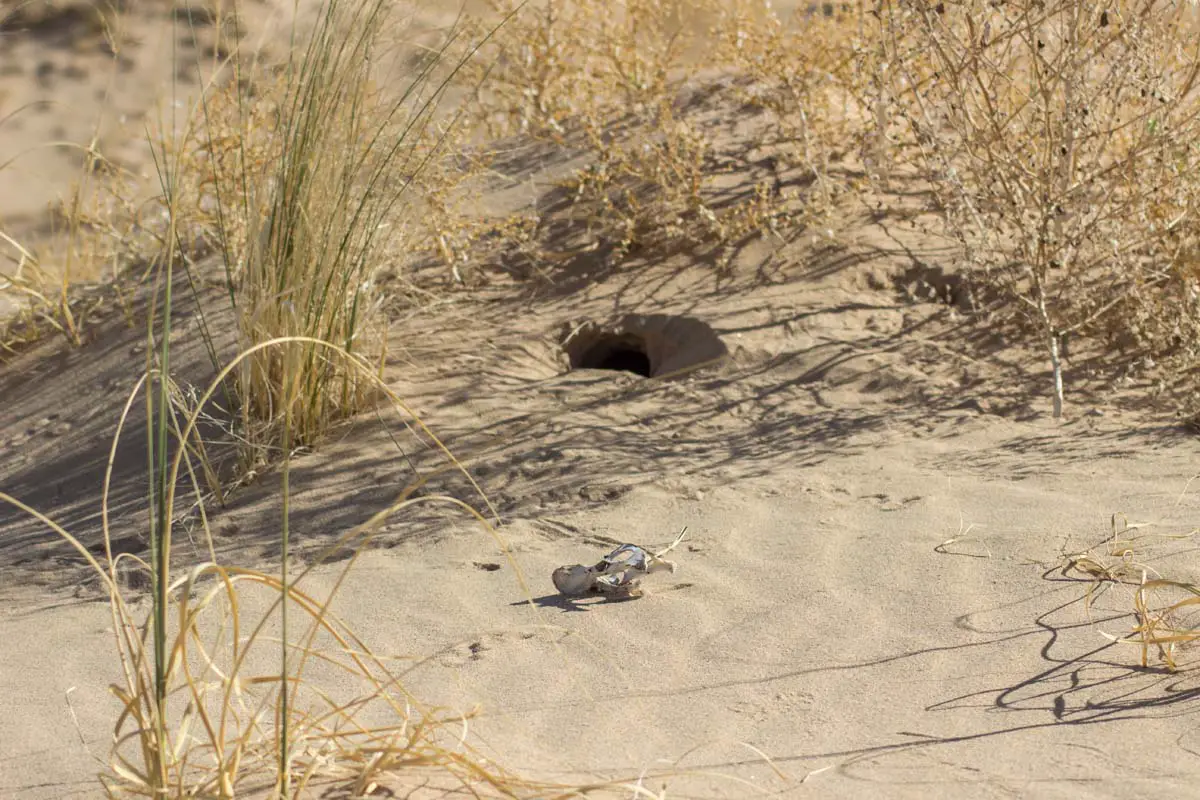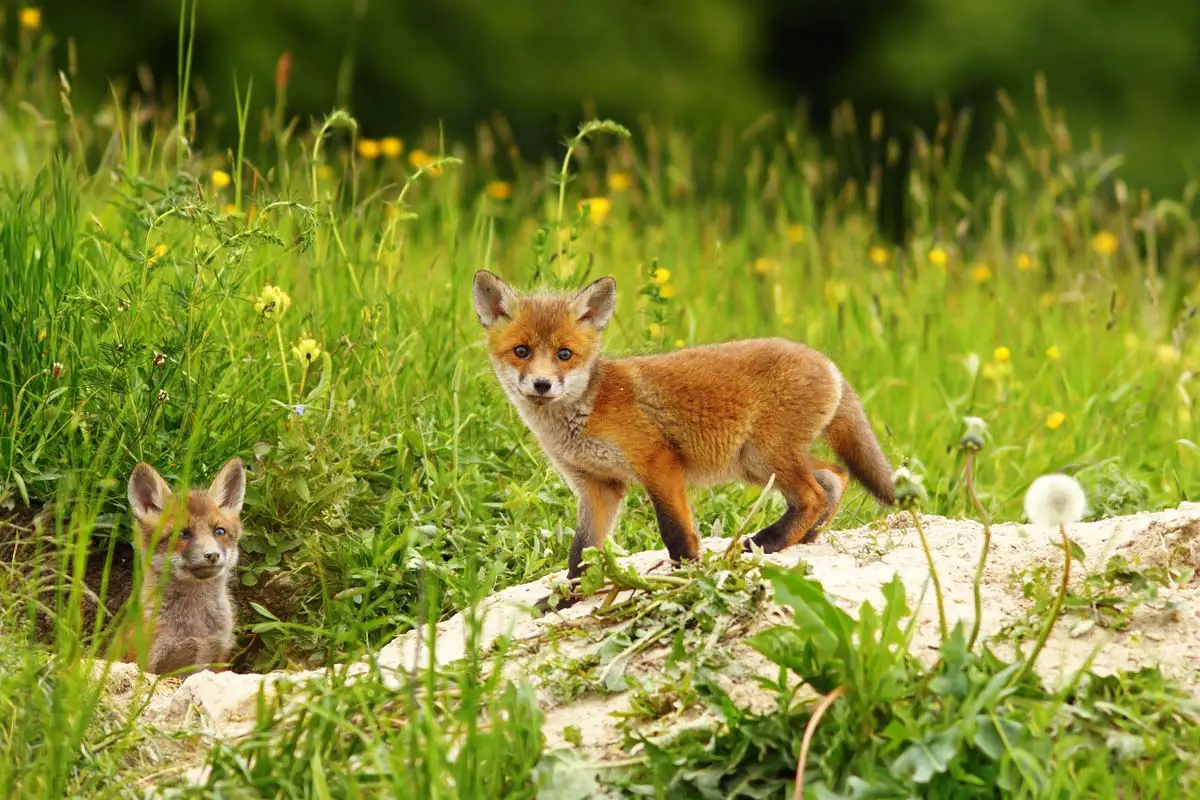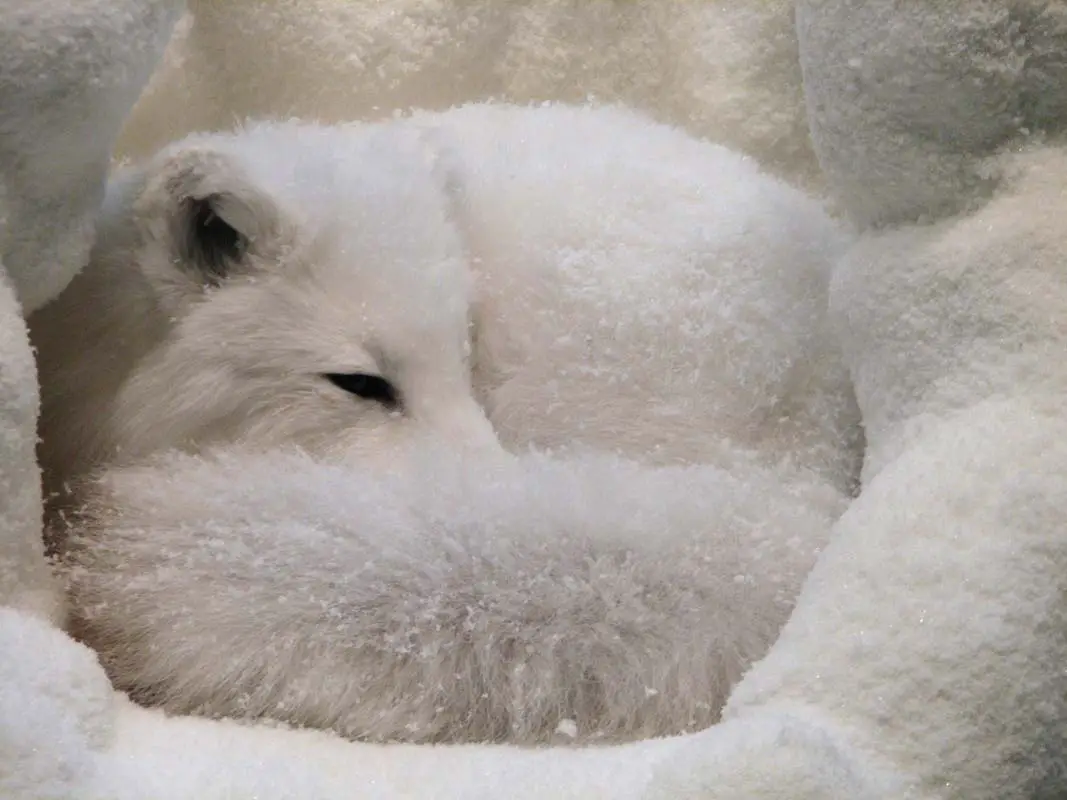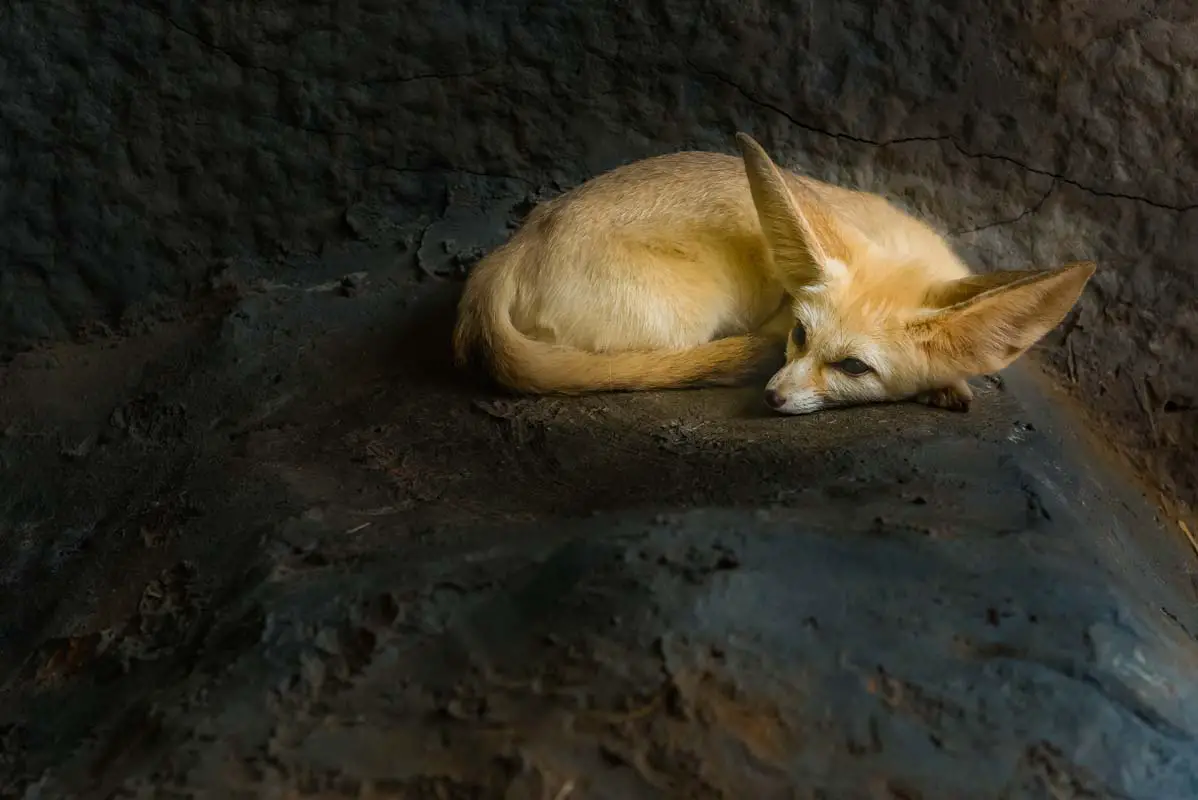Foxes dig dens in the ground, to raise their young, and store caches of food. Sometimes they inherit these dens, other times they will steal dens from other animals.
Fox dens, also known as burrows, and fox earths, are places where foxes store food and raise their young. A den is primarily a place for the vixen to give birth and raise her kits. Most foxes do not sleep in their dens.
Watch our Fox Dens Video
Subscribe to our Youtube Channel for weekly videos!
Fox dens are known by a few different names. In America, we call them dens, in England they are called earths, or burrows.
There is some confusion as to how the dens are used. Most people think foxes sleep in their dens, but this is usually not the case.
The dens are used primarily to raise young, and store caches of food. However, that doesn’t mean that they do not sleep in them from time to time.

How Can You Tell a Fox Den?
Fox dens can be hard to spot, the fox is great at sneaking in and out of them. They are usually found in wooded areas. The fox digs down in the earth and creates a tunnel that leads to multiple dug-out areas.
You can tell a fox den, by the size of the hole, how much foot traffic the animal leaves in front of it, and the smell. Foxes mark their territories, they use urine, for scent marking and chemical communication.
Usually, a family of foxes will have an area not too far from the den, where they do their business (poop and pee.) These areas are called latrines.
A fox makes its den in areas with dense vegetation. They will usually burrow, just under a large tree, or group of boulders.
It is possible to find feathers, or bones, in the area surrounding the fox den. They bring their kills back to their young, and store in their food cache-hole within the den.

How Deep Are Fox Dens?
Fox dens differ in size, depending on the geography, and the species of fox. The average red fox den is around 3-8 feet deep. The den itself can have multiple entrances and can be more than 50ft. long.
A small den has 1-2 entrances. The smaller dens are about 3 ft deep. They may have multiple holes dug inside for storing food and raising their young. They are around 10-20 ft deep.
A larger den has 3-8 entrances, with multiple dugout areas. Each area serves a function. These dens are about 8 ft deep and can be as long as 75 ft.
The entrances are around 7-8 inches in diameter. Sometimes there will be an area dugout, just under the entrance, where the foxes will sleep or watch over their young.
Some foxes have much more complex dens. Fennec foxes have been known to have 10-15 entrances, with very long tunnels.
The Average Fox Den
The average fox den is made of about 4-5 components. There is usually a hole or entrance, with a tunnel that is dug at an angle down into the earth. The tunnel has a couple of large holes dug inside.
Fox den components:
- Entrance
- Ramp
- Den
- Food Storage
The entrance leads down the sloped tunnel as a sort of ramp. The ramp leads to the main den that is from 3 to 8 ft deep vertically.
Along the tunnel, there will be a second area dugout to store food. Foxes are surplus killers and will save food in caches.
There may be more dugout areas, that lead to other entrances, or dens. An average fox den is large enough for them to give birth inside, and raise their young.
Some foxes will have larger more complex dens, and may even have more than just the parents and kits inside. Females from the previous litter will sometimes stick around to help raise the new litter of fox kits.
Foxes will also inherit dens from previous generations. They will sometimes build onto these dens, making them larger, or just use parts of larger complexes.

Fox Den Behaviors and Habits
The most surprising thing about a fox’s behavior inside of the den is that they rarely use them for sleeping. Foxes use their dens to raise their young, get out of the weather, and store food.
They will sometimes sleep in them when it extremely hot, or while watching over their young.
Foxes have been known to jump down a rabbit hole or other burrows made by animals, temporarily to get out of the weather, or to hide from a predator.
Natal dens are dens that are used for raising their young. It is not unusual for a pair of foxes to have more than one den.
In the tundra, the arctic fox will migrate if they can, during the winter, to warmer areas, where the female will have a natal den.
Foxes have their litters of kits in the den. The mother fox, (vixen) stays in the den, while the male fox hunts during the vixen’s pregnancy.
After the litter of kits is born, they stay in the den. Eventually, the vixen will start to hunt again, and both fox parents will bring the kills back to the den, to their food cache, and to feed the young.
The baby fox kits spend the first few weeks in the center of the den until they can open their eyes. Like puppies and kittens, they do not open their eyes for 10-12 days.
They stay in the den for the first month or two, while the parents bring them food to the den opening. This gets them used to coming out of the den.

Feeding Kits Inside the Den
Foxes keep food caches inside their dens, they also bury them around their home-range. When having their baby fox kits, the female will eat as much as she can, until it is time for her to go within the den to have the kits.
Inside the den, there will usually be a food cache, where the foxes have been killing in surplus, to stock up for the pregnancy.
The fox parents will chew up food, and regurgitate it back to the little fox kits for the first couple of weeks.
Then, they start leaving food inside of the den, and eventually, food gets left just outside the entrance.
This teaches the fox kits, to learn their boundaries, and to fend for themselves. They learn how to eat, and soon after this phase, they learn how to hunt.
Fox Den Food Caches
Foxes dig out areas in their dens to store food. They will kill more food than they need, and hide it with them, underground in the fox burrow.
Foxes will fill up their food caches, just before winter, and just before their breeding season. They make sure that they have plenty to eat during those times, and also during times when food can be scarce.
Sometimes, foxes will go a while, in between making a kill. To prepare for those times, they will make extra kills when there is more prey to be had. This is where their food cache, comes in handy.

Foxes Inheriting Dens
Foxes have been around for a very long time. They manage to adapt to their surroundings no matter what nature throws at them. The fox is one of the most widely dispersed animals on the planet.
Fox dens are usually passed down through many generations. The home-range of a fox is no more than 3-7 square miles. This is in an area that has plenty of prey and vegetation.
Some areas where food can be scarce, their range goes out to around 20 square miles. You may find some overlapping as well.
In an average area, with a good food and water source, you would find around 1-3 fox dens per 10 square miles. They may also have more than one den per family located within their home ranges.
Some of the fox earths (dens) they have inherited, from previous generations, and some are abandoned by other animals and taken by foxes.
In some of the remote parts of North America and Europe, you can find fox dens that have been passed down for hundreds of years.
Foxes Borrowing and Stealing Dens
A fox will borrow, and steal dens from other animals. When foxes are forced to move in a hurry, such as with bad weather, or being chased out of the area by a forest fire, they must seek refuge where they can find it.
This oftentimes happens with heavy rain, when a fox is out hunting and is trapped, they may take on another animal’s burrow.
Animals have been known to share their burrows, in extreme situations. Sometimes forest animals make the strangest bedfellows, such as foxes hiding in the burrow with rabbits if a predator is near.
They seem to recognize, that at that point, they are both prey to another predator. After that, however, it is fair game.
Foxes are great at adapting, such as arctic foxes, who will hold up in abandoned dens when caught out hunting in bad weather. Or when searching another territory for shelter, after migrating.

Do Foxes Have Multiple Dens?
Foxes usually have multiple dens. These dens are within their home-range, or just beyond. They may be freshly made dens or dens they have stolen or inherited.
When food is scarce, a fox may have to go beyond its home-range to hunt. They will often take refuge in abandoned dens if needed.
Or they have already scouted the area, they may have created burrows, or fox earths, in the surrounding territory. They are careful not to expand into dangerous territories, owned by predators, and other foxes.
In many cases, it is useful to have multiple dens, when the seasons change, so that they may have a natal den as well as a backup den.
In some rare cases, foxes will build their dens in overlapping home-ranges, that are closer than they normally are. This is usually done in overpopulated areas, or areas where many of the fox families are related.
Some abandoned dens may even serve as communal dens, where multiple fox families will eventually stay if they live in overlapping areas.

An Arctic Fox Den
Arctic fox dens are some of the most complex fox burrows out there. In the tundra, there is less nutrition. This means the arctic fox must find areas that have some vegetation.
The areas they choose have dens that are hundreds of years old. Passed down by previous generations. These areas are nutrient-rich, from a large amount of decomposed prey, left by the foxes.
In a way, arctic foxes are cultivators of gardens. Their den complexes are some of the largest of all of the fox dens.
They have many entrances and go deep under the snowbanks, and rocks. Arctic foxes have large litters. They have up to 10 kits in their litters. They have large den areas for raising their kits.
Arctic foxes keep large food caches dugout, so they can store food for the winter. They will dig out a section of permafrost and use it as a freezer for their food cache. Pretty smart, huh?
Arctic foxes are very intelligent and have adapted to their climate, despite huge problems with climate change.
The main food source of arctic foxes is lemmings. Oddly enough, lemmings are attracted to fox dens and will make their nests above them.
A study that was done on lemming populations, and arctic fox populations, shows that the number of arctic foxes that are born each year correlates with the number of lemmings that are born.
Having their main food source just above their dens, makes it much easier for them to kill and store food in the food caches they have built in the ice.
Some arctic foxes will migrate down into warmer areas of Canada, where they have their kits. The natal den, in the warmer climate, is built into the tree logs, below boulders, and in the ground where most of the snow has melted.
A fox earth is built around what is available. Foxes are solitary and like to stay unseen. They will often use tree stumps, limbs, and boulders as cover for their den.

Desert Fox Dens
Desert fox dens are similar to arctic fox dens, in a few ways. They are usually much more complex. Desert foxes build long tunnels that have 6-10 entrances.
They are built into the desert earth, below boulders, and in thick sand. Fennec foxes have been known to have very large family units, with dens that are multiple generations old.
Sometimes, desert foxes will locate their dens around vegetation since it is hard to come by. Many desert foxes do not drink a lot of water and must get their hydration from their prey, and the vegetation.
A desert fox den is 3-8 ft deep and can be as long as 70 feet. The fennec fox uses its huge ears to listen for predators and prey, while down in the den. They can hear well, and sound is amplified in their dens.
Desert fox dens have many entrances, that allow them to come and go, without being noticed by predators.
The temperatures underground are much cooler, and these foxes rely on dens to cool off when the summer heat hits hard.
Their dens can also attract some of their prey, such as insects and lizards. The fennec fox’s main diet is insects, as well as rodents.
Urban Fox Dens
The urban fox has learned to change its behavior over the years. With fox populations being interrupted by human development, urban foxes have adapted their behavior to live in the urban environment.
Urban foxes make their fox burrows in empty lots, under houses, and other places they find that are isolated.
They eat mostly rats, which helps reduce rodent populations. Foxes are not technically considered vermin, because they help kill other vermin, and they do not kill enough to be considered dangerous to farm animals or house pets.
They steal food from the trash and will take food from people’s gardens. Some people in urban places will set food out for them, which attracts dens in the area.
This can bring them closer to houses, which makes them a nuisance to some people, who have to deal with them having babies under their house every season.
They will also tear up a garden and will destroy parts of the house, to get down beneath it.
Fox Den Diagram
To help you get to know what a fox den looks like, we have put together this diagram that shows the elements, of an average red fox den.

The red fox is the most common of the foxes, and the most widely dispersed of all of the canids. You can find red fox dens in North America, Europe, and other places within the northern hemisphere.
Hopefully, this diagram will make a fox den easier for you to identify. The fox den has only a few elements.
The complexity of the den depends on how many generations have lived in the den, as well as the type of fox, and geography where it’s located.
Many dens that are passed down through generations, get added to by the new generations, making them even larger.
Let’s take a look at some of the elements of the fox den.
The Den Entrance (Hole)
The entrance to the den is a hole that is about 7-8 inches in diameter. Sometimes the hole will be hidden, beneath a boulder, or within a fallen tree.
Inside the entrance is a dugout area, where the fox can sit and watch for predators.
The Ramp
The ramp leads down to the main den area, this is the main tunnel of the fox den. The ramp goes down at a slope and leads far into the earth. This ramp usually goes down about 6ft vertically.
The Inner Den
The inner den is the main den, that is used for raising kits, and taking shelter from storms. The tunnel sometimes has a food cache, and a secondary den, with other entrances.
The Food Cache
The food cache is an area that is dugout for storing food. The cool temperatures keep food eatable for a couple of weeks. Foxes know when it’s time to store food away, for the kit season, or the winter.
Second Den
Sometimes a fox den will have multiple main dens inside of it. The tunnels can be as long as 70 ft and have many dugout areas.

Fox Den Under a Tree
Foxes sometimes build their dens under large trees, tree stumps, or within old fallen logs. This helps to camouflage them from predators and keep them safe.
The fox burrow is the perfect place for them to raise their young, in a wooded area that is secluded with lots of trees and vegetation.
Building their den-complexes under a tree makes their chances of being seen far less. They can allow their young to venture out of the den, and eventually, learn to hunt and go off on their own.
Are Fox Dens Protected?
Foxes can be considered endangered in certain areas. In those cases, their dens are protected. In the united states, a fence may even be put up around the den, to help protect them, as a visual aid to know that there is wildlife.
Arctic foxes are protected in some areas of the tundra, as well as their dens. Their dens in the arctic can be as old as 100-200 years old. Some of the oldest arctic fox dens have as many as 180 entrances, that span across large areas.
Some countries in the northern hemisphere, such as Norway, have passed laws against hunting, and have helped to protect arctic foxes and their dens.
See more about fox habitats.
Where do Fox make their dens?
Foxes can make their dens underground, in caves, among rocks or in hollow logs or trees. Quite often foxes will find abandoned dens from other animals and modify them by digging. You would be surprised to know underground dens can be up to 75 feet long and have multiple entrances.
How long do Foxes stay in a den?
After birth, foxes typically spend 4 to 5 weeks inside the den. They then emerge and begin playing outside, but always staying close. Both male and female foxes care for the young, guard the den, and bring food. Most adult foxes have multiple dens and if disturbed, will move (with their young) to another.
Frequently Asked Questions
Are fox earths and fox burrows the same thing?
Yes, these are just other phrases for the term “fox den.” They are used primarily in Europe and England.
Do foxes make their dens close to each other?
Foxes usually have a home-range of 3-7 square miles. They are solitary, and their dens usually do not overlap. However, a fox family may have more than one den in their home range.
In some cases, foxes will share their dens with other wildlife. Just like foxes, other animals will take refuge in abandoned dens. There are also cases of forest animals sharing dens, in bad weather.
Are fox dens safe for foxes?
Yes, they are. Foxes are very good at digging, whether in the ground, in the ice, or around large rocks, they have become adept at carving out their homes. Over time, a fox den may start to collapse, but not often.

